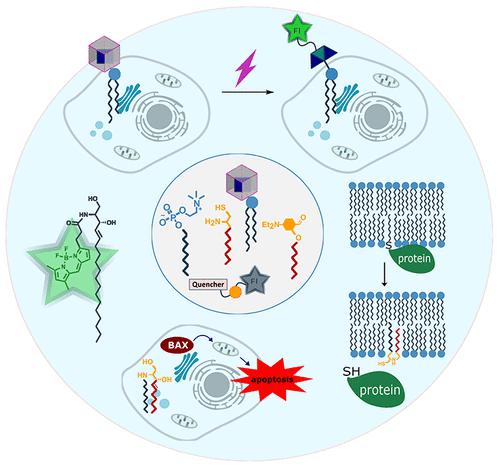当前位置:
X-MOL 学术
›
Acc. Chem. Res.
›
论文详情
Our official English website, www.x-mol.net, welcomes your
feedback! (Note: you will need to create a separate account there.)
Bioconjugation Strategies for Revealing the Roles of Lipids in Living Cells
Accounts of Chemical Research ( IF 16.4 ) Pub Date : 2022-10-10 , DOI: 10.1021/acs.accounts.2c00511 Caroline H Knittel 1 , Neal K Devaraj 1
Accounts of Chemical Research ( IF 16.4 ) Pub Date : 2022-10-10 , DOI: 10.1021/acs.accounts.2c00511 Caroline H Knittel 1 , Neal K Devaraj 1
Affiliation

|
The structural boundaries of living cells are composed of numerous membrane-forming lipids. Lipids not only are crucial for the cellular compartmentalization but also are involved in cell signaling as well as energy storage. Abnormal lipid levels have been linked to severe human diseases such as cancer, multiple sclerosis, neurodegenerative diseases, as well as lysosomal storage disorders. Given their biological significance, there is immense interest in studying lipids and their effect on cells. However, limiting factors include the low solubility of lipids, their structural complexity, and the challenge of using genetic techniques to directly manipulate lipid structure. Current methods to study lipids rely mostly on lipidomics, which analyzes the composition of lipid extracts using mass spectrometry. Although, these efforts have successfully catalogued and profiled a great number of lipids in cells, many aspects about their exact functional role and subcellular distribution remain enigmatic.
中文翻译:

揭示脂质在活细胞中作用的生物偶联策略
活细胞的结构边界由许多成膜脂质组成。脂质不仅对细胞区室化至关重要,而且还参与细胞信号传导和能量储存。异常的脂质水平与严重的人类疾病有关,例如癌症、多发性硬化症、神经退行性疾病以及溶酶体贮积症。鉴于它们的生物学意义,人们对研究脂质及其对细胞的影响有着极大的兴趣。然而,限制因素包括脂质的低溶解度、它们的结构复杂性以及使用遗传技术直接操纵脂质结构的挑战。目前研究脂质的方法主要依赖于脂质组学,它使用质谱法分析脂质提取物的成分。虽然,
更新日期:2022-10-10
中文翻译:

揭示脂质在活细胞中作用的生物偶联策略
活细胞的结构边界由许多成膜脂质组成。脂质不仅对细胞区室化至关重要,而且还参与细胞信号传导和能量储存。异常的脂质水平与严重的人类疾病有关,例如癌症、多发性硬化症、神经退行性疾病以及溶酶体贮积症。鉴于它们的生物学意义,人们对研究脂质及其对细胞的影响有着极大的兴趣。然而,限制因素包括脂质的低溶解度、它们的结构复杂性以及使用遗传技术直接操纵脂质结构的挑战。目前研究脂质的方法主要依赖于脂质组学,它使用质谱法分析脂质提取物的成分。虽然,











































 京公网安备 11010802027423号
京公网安备 11010802027423号